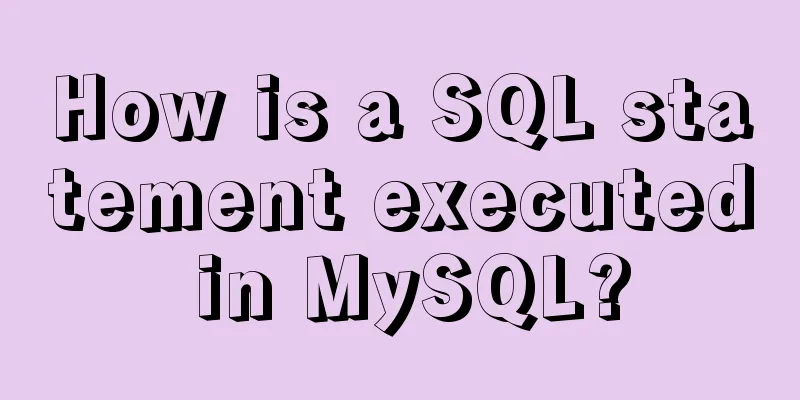Detailed explanation of how to create an updateable view in MySQL

|
This article uses an example to describe how to create an updateable view in MySQL. Share with you for your reference, the details are as follows: We know that in MySQL, views are not only queryable but also updatable. This means that we can use INSERT or UPDATE statements to insert or update rows of the base table through an updatable view. In addition, we can also use the delete statement to delete the rows of the underlying table through the view. However, to create an updatable view, the select statement defining the view must not contain any of the following elements:
If we use the temptable algorithm to create a view, we cannot update the view, but sometimes we can use inner joins to create an updateable view based on multiple tables. Without further ado, let's take a look at how to create an updateable view. Let's first try to create a view called officeInfo based on the offices table, which refers to three columns in the offices table: officeCode, phone and city: CREATE VIEW officeInfo AS SELECT officeCode, phone, city FROM offices; Next, use the following statement to query data from the officeInfo view: SELECT * FROM officeInfo; Execute the above query statement and get the following results: mysql> SELECT * FROM officeInfo; +------------+------------------+---------------+ | officeCode | phone | city | +------------+------------------+---------------+ | 1 | +1 650 219 4782 | San Francisco | | 2 | +1 215 837 0825 | Boston | | 3 | +1 212 555 3000 | NYC | | 4 | +33 14 723 4404 | Paris | | 5 | +86 33 224 5000 | Beijing | | 6 | +61 2 9264 2451 | Sydney | | 7 | +44 20 7877 2041 | London | +------------+------------------+---------------+ 7 rows in set Then, use the following update statement through the officeInfo view to change the officeCode value to 4, the office telephone number: UPDATE officeInfo SET phone = '+86 089866668888' WHERE officeCode = 4; Finally, verify the changes by querying the data in the officeInfo view: mysql> SELECT * FROM officeInfo WHERE officeCode = 4; +------------+------------------+-------+ | officeCode | phone | city | +------------+------------------+-------+ | 4 | +86 089866668888 | Paris | +------------+------------------+-------+ 1 row in set We can check whether the views in the database are updatable by querying the is_updatable column from the views table in the information_schema database. For example, let's query the luyaran database to get all views and show which views are updatable: SELECT table_name, is_updatable FROM information_schema.views WHERE table_schema = 'luyaran'; Execute the above query statement and get the following results: +------------------+--------------+ | table_name | is_updatable | +------------------+--------------+ | aboveavgproducts | YES | | bigsalesorder | YES | | customerorders | NO | | officeinfo | YES | | saleperorder | NO | +------------------+--------------+ 5 rows in set Let's try to delete rows through a view. First, create a table called items, insert some rows into the items table, and create a view that queries items with a price greater than 700:
USE testdb;
-- create a new table named items
CREATE TABLE items (
id INT AUTO_INCREMENT PRIMARY KEY,
name VARCHAR(100) NOT NULL,
price DECIMAL(11 , 2 ) NOT NULL
);
-- insert data into the items table
INSERT INTO items(name,price)
VALUES('Laptop',700.56),('Desktop',699.99),('iPad',700.50);
-- create a view based on items table
CREATE VIEW LuxuryItems AS
SELECT
*
FROM
items
WHERE
price > 700;
-- query data from the LuxuryItems view
SELECT
*
FROM
LuxuryItems;
After executing the above query statement, the following results are obtained: +----+--------+--------+ | id | name | price | +----+--------+--------+ | 1 | Laptop | 700.56 | | 3 | iPad | 700.5 | +----+--------+--------+ 2 rows in set After that, use the DELETE statement to delete the row with id 3: DELETE FROM LuxuryItems WHERE id = 3; mysql returns a message indicating that 1 row was affected:
Let's check the data again through the view: mysql> SELECT * FROM LuxuryItems; +----+--------+--------+ | id | name | price | +----+--------+--------+ | 1 | Laptop | 700.56 | +----+--------+--------+ 1 row in set We can also query data from the base table items to verify that the DELETE statement actually deleted the row: mysql> SELECT * FROM items; +----+---------+--------+ | id | name | price | +----+---------+--------+ | 1 | Laptop | 700.56 | | 2 | Desktop | 699.99 | +----+---------+--------+ 2 rows in set We can see that the row with ID 3 is deleted in the base table. Okay, that’s all for this record. Readers who are interested in more MySQL-related content can check out the following topics on this site: "MySQL query skills", "MySQL transaction operation skills", "MySQL stored procedure skills", "MySQL database lock related skills summary" and "MySQL common function summary" I hope this article will be helpful to everyone's MySQL database design. You may also be interested in:
|
<<: Implementation of grayscale release with Nginx and Lua
>>: Vue implements simple slider verification
Recommend
Installation tutorial of the latest stable version of MySQL 5.7.17 under Linux
Install the latest stable version of MySQL on Lin...
Vue-router example code for dynamically generating navigation menus based on backend permissions
Table of contents Vue.js 1. Register global guard...
Uniapp implements DingTalk scan code login sample code
Since Uniapp does not have DingTalk authorization...
Nginx configuration location matching rules example explanation
The scope of nginx configuration instructions can...
How to implement Linux automatic shutdown when the battery is low
Preface The electricity in my residence has been ...
How to deploy SpringBoot project using Dockerfile
1. Create a SpringBooot project and package it in...
VMware vCenter 6.7 installation process (graphic tutorial)
background I originally wanted to download a 6.7 ...
Common solutions for Mysql read-write separation expiration
The pitfalls of MySQL read-write separation The m...
The actual process of implementing the guessing number game in WeChat applet
Table of contents Function Introduction Rendering...
Cross-host communication between docker containers-overlay-based implementation method
Overlay network analysis Built-in cross-host netw...
What is the length of a function in js?
Table of contents Preface Why How much is it? Num...
Six weird and useful things about JavaScript
Table of contents 1. Deconstruction Tips 2. Digit...
Zabbix's psk encryption combined with zabbix_get value
Since Zabbix version 3.0, it has supported encryp...
How to deploy code-server using docker
Pull the image # docker pull codercom/code-server...
Detailed explanation of the difference between a href=# and a href=javascript:void(0)
a href="#"> After clicking the link, ...









